Last week I looked at the popularity of various first names in movies over the past two decades. The process involved building up a vast database of acting credits, noting both the gender of the fictional role and of the performer representing them on screen.
This led to some readers getting in touch to ask what else can be done with that dataset. Two different readers enquired about whether the gender of the directors affected the percentage of women in the cast. It’s a great question and so I took a look.
As a reminder, this is looking at 440,956 cast credits across 8,415 movies released between 2000 and 2021 (more info in the Notes at the end). We’re looking at everyone who received an acting credit, no matter their importance to the plot, fame, salary or screen time.
Let’s start by looking at what percentage of acting roles are given to women, and then we can factor in the directors’ gender.
What percentage of acting roles are played by women?
Across the almost half million acting roles I studied, 26.8% were performed by women.
The year with the highest representation was 2005 (in which 28.3% of acting credits went to women) and the poorest was 2021 (24.3%).
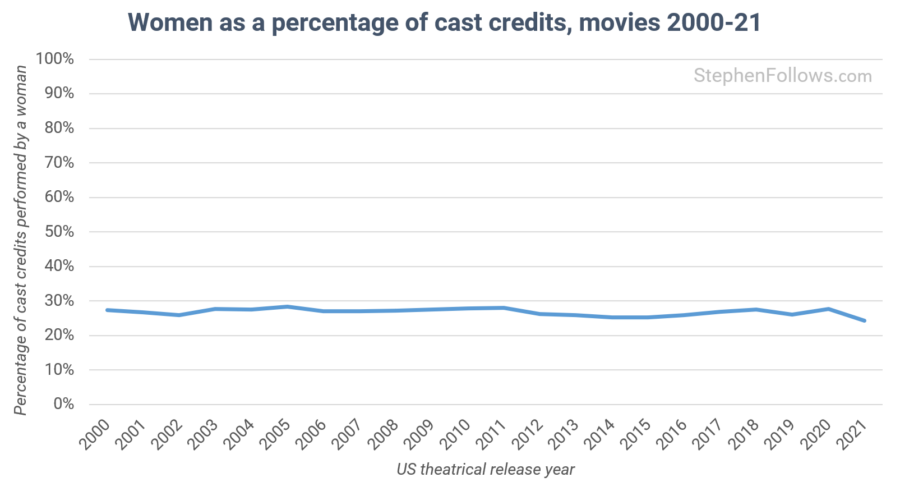
Note: Personally, I would not read too much into the dip in 2021 as the criterion for inclusion was altered to take account of changing release patterns during the pandemic, and so it could be viewed as reading too much into a small change at a highly volatile time for movies.
Which genres feature the most women?
When we dig into the data a little deeper we can see that not all movies are the same.
The films with the fewest women on screen were Westerns (16.7% of roles were performed by women), War (17.0%) and Historical films (18.3%).
At the other end of the spectrum, Romance films featured 33.7% women, followed by Musicals (31.1%) and Music-based films (30.0%).
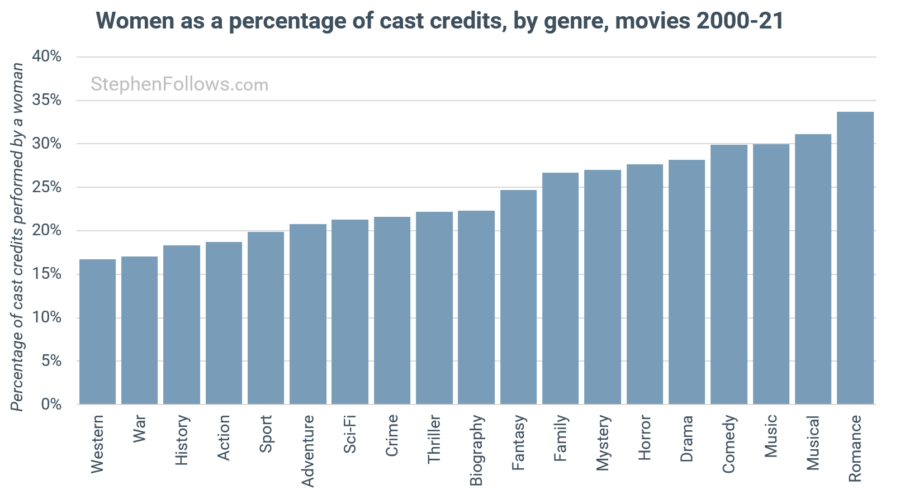
Does the directors’ gender affect the gender of the cast?
Now let’s answer our original question – do films directed by women feature a greater number of women in the cast than those not directed by a woman?
For simplicity’s sake, I am looking at whether a movie had at least one woman in its directing team. The vast majority of films only have one director (more on that here: How many films does the average director make?) but if it’s a directing partnership or a multi-part film, then just having one woman would be enough to trigger my “directed by a woman” criteria here.
Across all genres, a woman at the helm meant more acting roles for women.
The biggest differences were among Westerns, which when directed by at least one woman had an average of 30.8% of acting roles going to women, compared to just 16.4% of those in films not directed by a woman.
The most similar were Musicals – 33.9% women when directed by women, and 30.8% women when not directed by a woman.
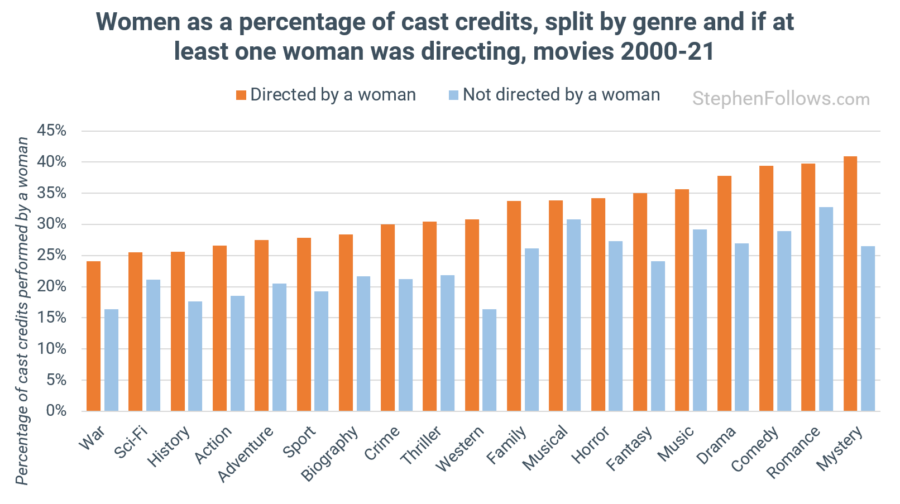
Read more
If you’d like to delve deeper into some of the topics covered here, then you may enjoy the following links:
- My data research on women in film (such as How often are women hired in key film departments? and my major research paper Cut Out Of The Picture)
- My data research on acting
- My data research on directing (maybe start with Are women less likely to direct a second movie than men?)
Notes
Today’s research is looking at live-action movies released in Domestic cinemas between 2000 and 2019, and those movies released by one of the major studios on any platform in 2020 and 2021. The raw data came from IMDb, The Numbers and Wikipedia.
Genre is determined by IMDb’s criteria, which allows a film to have multiple genres. Across the dataset, the average film had just over 2.5 genres.
Gender was determined by pronouns in biographies, online classifications (e.g. some movie databases spit ‘actors’ and ‘actresses’) and my past work on gender. I have split the gender stats into two categories as this reflects the way data has been captured over the period I studied. In the future, there may more nuanced databases which capture gender fluidity and non-binary identities, but until then we’re left with a rather crude binary approach. I used the gender the person currently publicly identifies as. I am always looking for better and more detailed ways to study and report on gender. If you think I can do better, reach out and we can chat.
Epilogue
This was another great question from readers.
If there’s something you’ve always wanted to know, or if you have a suggestion of how I can use any of my existing datasets, please do get in touch.

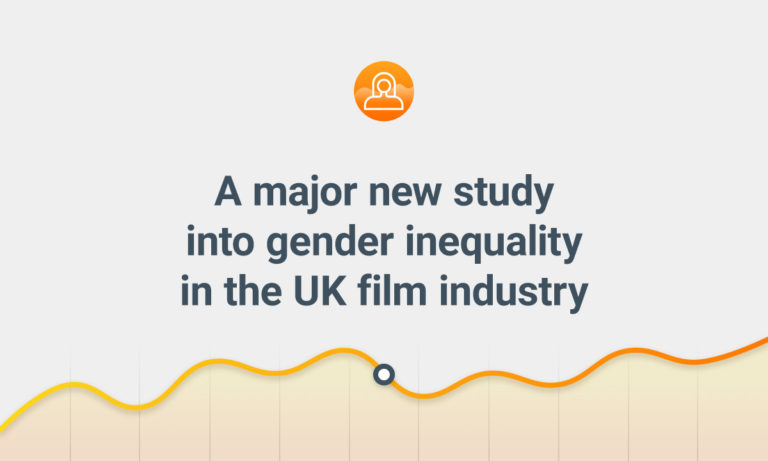
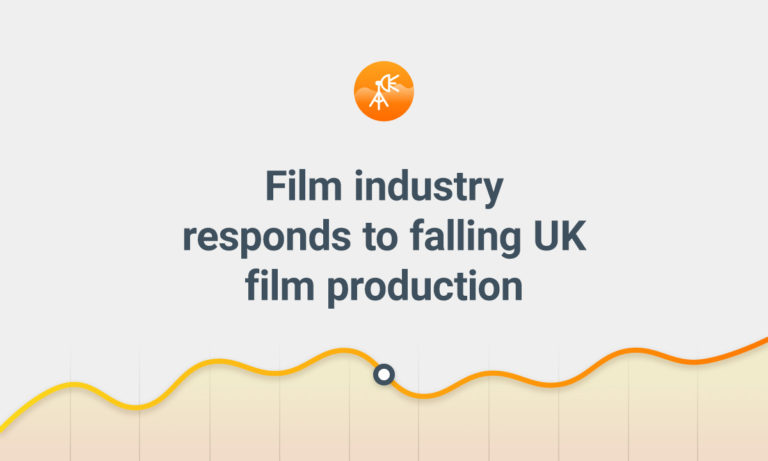
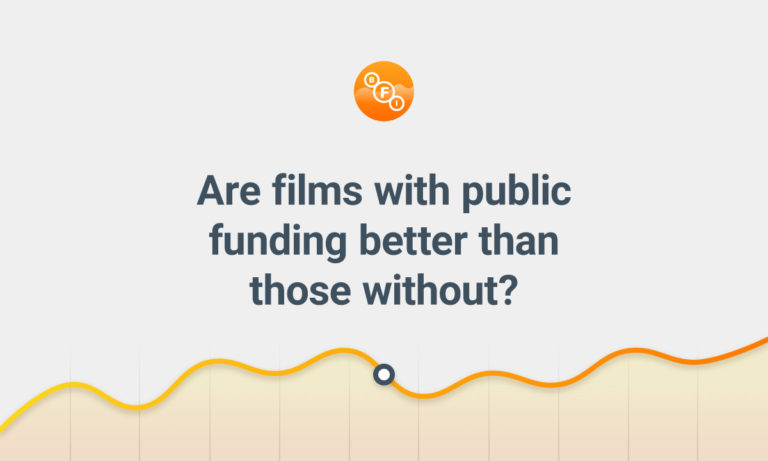

Comments
It’s getting exhausting having to read reviewers spend whole paragraphs prefacing or ending with why and how they don’t mean to offend non binary people. These lengthy apologies are becoming pathetic and spineless. Nearly half of all humans have a penis and the other half nearly all have a vagina. Some think in their heads they are a different gender and some people believe they are an animal, but bending over backwards for the most minute of minorities is cringeworthy reading/ watching. Don’t become codependent and walk on egg shells around people; you’re just going to suppress a lot of authentic anger that will some day explode. Otherwise like your articles a good deal
Hi Christopher
Thank you for your comment. The wider topic is much bigger than the scope of this blog and so I going to avoid getting into the larger topic of gender and identity here. It’s way beyond my experience, my knowledge and better informed people elsewhere can have that debate. What I can talk about is film data research and how I tackle the reporting of my work.
For me, it comes down to two things…
Firstly, my role as a researcher is to reflect the world as it is. As a film fan I hugely prefer comedies to westerns but seek to report on all genres equally and fairly. I want to ignore my subjective views or experiences in favour of reporting what is actually happening. It’s clear that a non-insignificant minority of people are choosing to identify outside of a strict binary sense and so that’s something we should want to measure. The majority of things I study with regard to gender are about culture (of movies and within movies) or about how the filmmakers are treated. These have more to do with how they interact with the world, than what’s under their clothes. Therefore, taking into account the complexities of gender identity and their effects feels like a valuable datapoint to measure and track.
Secondly, it takes a tiny amount of time to acknowledge that the current data methods don’t track everyone’s real world experiences. It doesn’t impact the work and takes no additional resources to do. From what I have heard, many of these people feel underrepresented, under valued and ignored. Their experiences are diminished and dismissed in almost all areas of their life. Given how easy it is for me to mention and how much it could mean to someone, it feels like the right thing to do.
So I don’t see it as pathetic, spineless or walking on eggshells, but rather a matter of accuracy and kindness.
It’s not something I HAVE to do, it’s something I am fortunate to have the opportunity to do.
Beautifully said.
Love this 👏🏻👏🏻👏🏻
“From what I have heard, many of these people feel underrepresented, under valued and ignored. Their experiences are diminished and dismissed in almost all areas of their life. Given how easy it is for me to mention and how much it could mean to someone, it feels like the right thing to do.“